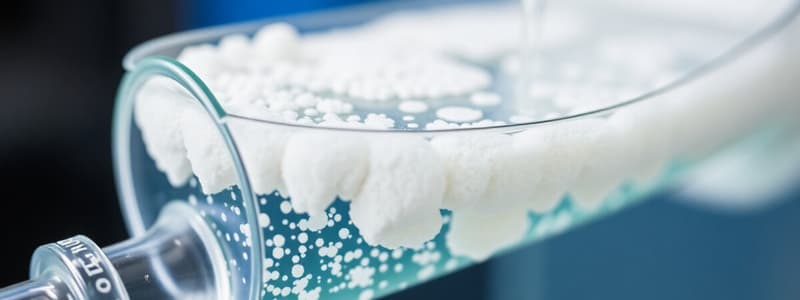Podcast
Questions and Answers
Why are elixirs generally considered superior to aqueous syrups?
Why are elixirs generally considered superior to aqueous syrups?
Elixirs maintain both water-soluble and alcohol-soluble components, making them more versatile.
What is the significance of an elixir containing more than 10% alcohol?
What is the significance of an elixir containing more than 10% alcohol?
Such elixirs are usually self-preserving and do not require an antimicrobial agent.
What are the advantages of using artificial sweeteners in elixirs?
What are the advantages of using artificial sweeteners in elixirs?
Artificial sweeteners reduce sugar content while enhancing palatability without adding calories.
Describe how to prepare an elixir containing both alcohol-soluble and water-soluble ingredients.
Describe how to prepare an elixir containing both alcohol-soluble and water-soluble ingredients.
What role do flavoring agents play in the formulation of elixirs?
What role do flavoring agents play in the formulation of elixirs?
List the primary components that make an elixir a suitable vehicular option for medication.
List the primary components that make an elixir a suitable vehicular option for medication.
What are the disadvantages of elixirs in terms of patient demographics?
What are the disadvantages of elixirs in terms of patient demographics?
How does the storage requirement for elixirs contribute to their longevity?
How does the storage requirement for elixirs contribute to their longevity?
What precaution should be taken if an elixir appears cloudy after preparation?
What precaution should be taken if an elixir appears cloudy after preparation?
Why is flexibility in dosage a notable advantage of elixirs?
Why is flexibility in dosage a notable advantage of elixirs?
What is the primary purpose of the clarification process in pharmaceutical liquid preparations?
What is the primary purpose of the clarification process in pharmaceutical liquid preparations?
How does particle size influence the choice of clarification method?
How does particle size influence the choice of clarification method?
In what scenario would settling be considered ineffective as a clarification method?
In what scenario would settling be considered ineffective as a clarification method?
What are the two types of settling methods used in clarification?
What are the two types of settling methods used in clarification?
Identify two factors that affect the rate of settling in the clarification process.
Identify two factors that affect the rate of settling in the clarification process.
What does the filtration method depend on in terms of the liquid's characteristics?
What does the filtration method depend on in terms of the liquid's characteristics?
What role does the gravitational constant play in centrifuge clarification?
What role does the gravitational constant play in centrifuge clarification?
Which type of filter media is typically used for simple clarification purposes?
Which type of filter media is typically used for simple clarification purposes?
State one advantage and one disadvantage of using the percolation method for clarification.
State one advantage and one disadvantage of using the percolation method for clarification.
What would be a critical consideration when selecting a method for removing volatile oils during clarification?
What would be a critical consideration when selecting a method for removing volatile oils during clarification?
What is the primary therapeutic benefit of antihistamine elixirs?
What is the primary therapeutic benefit of antihistamine elixirs?
Why is it important for the flavor and color of a medicated elixir to not conflict with the medicated ingredients?
Why is it important for the flavor and color of a medicated elixir to not conflict with the medicated ingredients?
What side effects are commonly associated with the use of barbiturate sedative and hypnotic elixirs?
What side effects are commonly associated with the use of barbiturate sedative and hypnotic elixirs?
How does the alcohol content in Digoxin elixir impact its usage in children?
How does the alcohol content in Digoxin elixir impact its usage in children?
What distinguishes long-acting barbiturate elixirs from short-acting ones?
What distinguishes long-acting barbiturate elixirs from short-acting ones?
Describe the solubility characteristics of volatile substances in spirits compared to water.
Describe the solubility characteristics of volatile substances in spirits compared to water.
What adverse effects may occur with antihistamine elixirs aside from sedation?
What adverse effects may occur with antihistamine elixirs aside from sedation?
What is the role of compatibility in the formulation of medicated elixirs?
What is the role of compatibility in the formulation of medicated elixirs?
Why might prolonged use of barbiturate sedative elixirs lead to dependence?
Why might prolonged use of barbiturate sedative elixirs lead to dependence?
What is the effect of mixing aromatic spirits with water, and why does this occur?
What is the effect of mixing aromatic spirits with water, and why does this occur?
Flashcards are hidden until you start studying
Study Notes
Clarification
- Final step in liquid preparation
- Eliminates unwanted suspended materials from raw materials, equipment, vehicles, or other sources
Factors Affecting Clarification Method Selection
- Particle size of the unwanted suspended material
- Larger particles are easily removed by eye
- Smaller particles require specialized devices
- Physical properties of the unwanted suspended material
- For example, removal of excess volatile oils
- Quantity of the unwanted suspended material
- Small quantities can be removed using filtration
- Large quantities require alternate methods
- Characteristics of the fluid medium
- Consider liquid viscosity, temperature effects, and exposure to air and light
- Speed of the method
- Faster methods are preferred
Settling Method
- A simple and primitive method allowing the product to stand until separation occurs
- Two types:
- Upward settling: Suspended materials are less dense than the liquid media
- Downward settling: Suspended materials are denser than the liquid media
- Factors affecting settling:
- Rate of settling (dx/dt)
- Diameter of particles (d)
- Density of particles (pi)
- Density of medium (pe)
- Gravitational constant (g)
- Viscosity of medium (η)
Centrifuge Clarification
- Accelerates settling by modifying the gravitational constant
Filtration and Percolation Method
- Percolation:
- Simple filtration through a piece of cotton or cloth
- Filtration:
- More advanced technique involving passing through a filter media, such as filter paper
- Factors affecting filtration rate:
- Viscosity of liquid medium
- Size and shape of suspended particles
- Purpose of filtration (clear liquid or other)
- Surface area (A)
- Viscosity of medium (η)
- Thickness of cake layer (I)
Types of Filter Media
- Sheets of woven materials: Cotton, wool, or filter papers
- Porous plates: Made from stones, ceramic, or glass with different pore sizes
- Membrane filter: Made from cellulose or its derivatives with different pore sizes
- Unwoven fibrous materials: Used for simple clarification
- Granular or powdered materials: Sand, charcoal, or any other inert material
- Ultrafilter and microsieve: Separate micro-organisms and very small particles
Elixirs
- Clear hydroalcoholic solutions for oral use
- Usually sweetened and flavored for better palatability
- Non-medicated elixirs: Used as vehicles
- Medicated elixirs: Used for therapeutic effects
Properties of Elixirs
- Less Viscous than Syrups: Due to lower sugar content
- Less Sweet than Syrups: Due to lower sugar content
- Better than Aqueous Syrups: Maintain both water-soluble and alcohol-soluble components
- Easy to Prepare: Simple solution method
- Variable Alcohol Content: Depends on the solubility of the components
Sweetening Agents for Elixirs
- Sucrose or sucrose syrup
- Sorbitol
- Glycerin
- Artificial sweeteners: Saccharin
Components of Elixirs
- Flavoring agents: Enhance palatability
- Coloring agents: Enhance appearance
Self-Preservation of Elixirs
- Elixirs containing more than 10% alcohol are usually self-preserving and do not require an antimicrobial agent
Dosage of Medicated Elixirs
- Formulated to provide the usual adult dose in a convenient measure
- Usually one or two teaspoonfuls (5 or 10 mL)
Advantages of Elixirs
- Flexible dosage: Easy to administer to patients who have difficulty swallowing solid forms
Disadvantages of Elixirs
- Alcoholic content: May be unsuitable for children or adults who avoid alcohol
Storage of Elixirs
- Store in tight, light-resistant containers and protect from excessive heat
Preparation of Elixirs
- Simple solution involving agitation or admixture of liquid ingredients
- Alcohol-soluble materials: Dissolved in alcohol
- Water-soluble components: Dissolved in purified water
- Add aqueous solution to alcoholic solution: Maintain the highest possible alcoholic strength
- Final volume: Made up with the specified solvent or vehicle
- Cloudy mixture: May occur due to separation of flavoring oils
- Permit to stand for several hours to separate the oil globules
- Talc filter aid: Absorbs excessive amounts of oils
Nonmedicated Elixirs
- Uses:
- Addition of a therapeutic agent to a pleasant-tasting vehicle
- Dilution of an existing medicated elixir
Nonmedicated Elixir Selection
- Solubility and stability: Of the drug substance
- Alcoholic concentration: Similar to the medicated elixir to be diluted
- Flavor and color: Should not conflict with the medicated elixir
- Compatibility: All components should be chemically and physically compatible
Common Nonmedicated Elixirs
- Aromatic elixir
- Compound benzaldehyde elixir
- Isoalcoholic elixir
Medicated Elixirs
- Employed for the therapeutic benefit of the medicinal agent
Antihistamine Elixir
- Uses: Symptomatic relief of allergic disorders
- Mechanism of action: Suppress symptoms caused by histamine
- Side Effect: Sedation
- Warning: Avoid activities requiring mental alertness
- Other adverse effects: Dryness of nose, throat, and mouth; dizziness; and disturbed concentration
Barbiturate Sedative and Hypnotic Elixirs
- Uses: Produce various degrees of central nervous system depression
- Effects: Sedation, hypnosis, respiratory depression (in high doses)
- Dosage:
- Small doses: Sedation, daytime use
- Larger doses: Hypnotics, bedtime use
- Classification:
- Long-acting: Maintain daytime sedation
- Intermediate-acting and short-acting: Treat insomnia
- Ultra-short-acting: Induce anesthesia
- Side Effect: Drowsiness, lethargy
- Prolonged use: May lead to psychic or physical dependence
Digoxin Elixir
- Properties: Cardiotonic glycoside, insoluble in water but soluble in dilute alcohol
- Alcohol Content: About 10%
- Dosage: Carefully determined for each individual patient
- Available Dosage Forms: Tablets and elixir
- Elixir Use: Children
- Importance: Dosage forms may exhibit different bioavailability characteristics
Spirits
- Definition: Alcoholic solutions of volatile substances
- Alcohol Concentration: Usually over 60%
- Solubility: Greater solubility of volatile substances in alcohol than in water
- Preparation: Mixing with water or aqueous preparation forms milky preparation due to separation of volatile substances
- Uses:
- Flavoring agents
- Therapeutic value of the aromatic solute
Common Spirits
- Aromatic ammonia spirit
- Camphor spirit
- Compound orange spirit
- Peppermint spirit
Studying That Suits You
Use AI to generate personalized quizzes and flashcards to suit your learning preferences.




